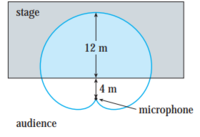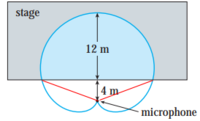MathsLearner
New member
- Joined
- Aug 13, 2017
- Messages
- 27
The problem summary statement is, When recording live a microphone is used with cardioid pickup pattern. suppose the microphone is placed 4m from the front of the stage and the boundary is given by cardioid r = 8 + 8sinθ, where r is measured in meters and the microphone at pole. What is the area of the optimal pickup range of the microphone.

My attempt is i am finding the area of the blue region.
The total area is
A = ∫02π2r2dθA=∫02π32(1+sinθ)2dθ = 301.59
But i am confused how much area i need to subtract. That is which is the point i have to take at 0deg? What is the angle at which cardioid intersects with the stage. Please advise.

My attempt is i am finding the area of the blue region.
The total area is
A = ∫02π2r2dθA=∫02π32(1+sinθ)2dθ = 301.59
But i am confused how much area i need to subtract. That is which is the point i have to take at 0deg? What is the angle at which cardioid intersects with the stage. Please advise.


